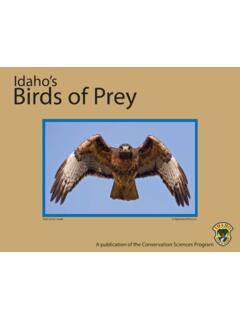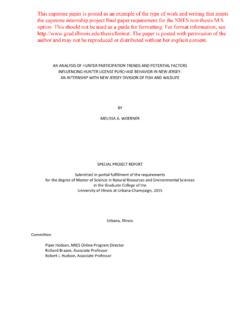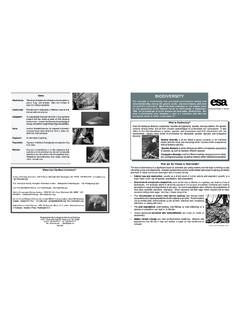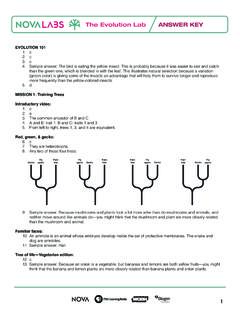Transcription of Model 1 — Predator—Prey Relationships Relationship …
1 Ecological RelationshipsWhat symbiotic Relationships are seen in ecosystems?Why?All living organisms need each other in some way to survive. This can include the interactions betweenpredators and their prey , the close associations between and among living things (symbiosis), or the com-petitive Relationships between and among species. All of these Relationships may be equally advantageousto the parties involved, or they may be more beneficial to one organism over the 1 Predator prey RelationshipsRelationship between Snowshoe Hares and Lynx180 Number of haresNumber of lynx160140120100806040201845 1850 1855 1860 1865 1870 1875 1880 1885 1890 1895 1900 1905 1910 1915 1920 1925 1930 1935 Yearl.
2 Refer to the graph in Model What does the y axis on che left represent?Number What does che y axis on the right represent?Number For both y axes, what value do che numbers on the axes need to be multiplied by?103 or What was che approximate population of snowshoe hares in 1865?155, was the approximate population of lynx in 1865? the number of snowshoe hares is high, what happens to the number of lynx? Use actualdata from the graph to support your number oflynx is usually also high (any data points acceptable). happens to the population of lynx as the number of snowshoe hares decreases?
3 Use actualdata from the graph to support your population oflynx declines also (any data points acceptable). an explanation for the apparent cause and effect Relationship between the populations oflynx and a lot offood is available (snowshoe hare) more lynx are likely to survive and their populationcan does this information tell youa. about the effect of size of prey populations on the number of predators?Ifa large food supply ( prey ) is available, then the predator population can about the effect of predators on the populations of their prey ?
4 When the predator population becomes too large, they consume the food ( prey ) and so the overallprey population is other factor would influence the size of the hare population in addition to the size of thepopulation of lynx?The amount offood available to the 'Activities for High SchoolModel 2 SymbiosisOrganism 1 Organism 2 DogFungusTermiteSharkCaccleHumanFleaAlga eCellulose-digestingbacteriaRemoraCattle egretTapewormDescription of the relationshipThe flea feeds on blood from the dog. There is no benefit to the dog and che itching andbites may lead to photosynthetic algae provide food for the fungus, which in turn provides a suitableliving environment for the bacteria in the gut of the termitebreakdown and feed on some of thecellulose taken in by the termite.
5 Thetermite would be unable to digest cellulosewithout these bacteria and they gain anadditional source of nutrition from thesurplus digested Remora fish swim alongside the sharkand cake scraps of food that the shark dropsduring feeding. The shark does not eat cheRemora and appears unaffected by cattle egret follows herds of cattle andeats the insects that the cattle stir up as theymove through the grassland. The cattleappear to be unaffected by the tapeworm lives in che small intestineswhere it feeds and grows, robbing thehuman of essential Refer co the information given in Model ticRelationshipParasitismMutualismMutual ismCommensalismCommensalismPa rasitisma.
6 In the dog and flea Relationship , is there a benefit for one of the organisms or for both?Only one Is either the dog or the flea harmed by chis Relationship ?The dog is Which other Relationship in Model 2 is similar to chat between the dog and flea?Human and Relationships18110. Refer to the fungus and algae Relationship in Model Is there a benefit for one of the organisms or for both? Is either the fungus or the algae harmed by this Relationship ? Which ocher Relationship in Model 2 is similar co that between the fungus and the algae?
7 Termite and cellulose-digesting l. Refer co the shark and remora Relationship in Model In che shark and remora Relationship , is there a benefit for one of the organisms or for both?Only one benefits, the Is either the shark or the remora harmed by chis Relationship ?c. Which other Relationship in Model 2 is similar co that between the shark and che remora?Cattle and cattle This!Symbiotic Relationships are identified by how they affect the organisms involved. The three types of sym-biotic Relationships are listed : Both organisms benefit from the Relationship .
8 Parasitism: One organism benefits and the ocher is harmed. Commensalism: One organism benefits and there is no effect on che Using the information from che Read This! box, label each of the Relationships in Model 2 asmutualism, parasitism or Model With your group, choose one of the organism pairs from Model 2 and justify why you catego-rized the Relationship as you will vary. Students sh01dd explain how the description meets the definition ofthe for High School BiologyPOGIIP' Model 3 Inter- and Intra-specific CompetitionGraph AGraph BP.
9 Aurelia and P. caudatum grown separatelyP. aurelia and P. caudatum grown togetherP. aureliac:oOP. aurelia3P. coudatumOP. coudatum2020 Number of DaysNumber of DaysGraph CRate of growth of tadpoles in populations of different Minimum mass neededfor individuals40 individuals 160 individuals01 2345678 9 10 Time (weeks) are the names of che species in graphs A and B in Model 3?P. aurelia and P. graph shows competition between two different species? graph in Model 3 shows population growth for only one species? is the difference between the growing conditions in graph A and graph B?
10 In graph A the two species are grown separately and in graph B they are grown Relationships18318. I? caudatum and I? aurelia are both species of Paramecium, a microscopic protozoan. P. caudatumis the larger of the two species. When grown separately, which of the two species reaches a largerrelative population size after 20 days?After 20 days P. aurelia reaches a larger When grown separately is there a substantial difference in the relative population size of the twotypes of paramecia after 20 days?While some difference is seen, it is not Compare graphs A and B in Model Which population of species of Paramecium is more affected when the two species are growntogether?





